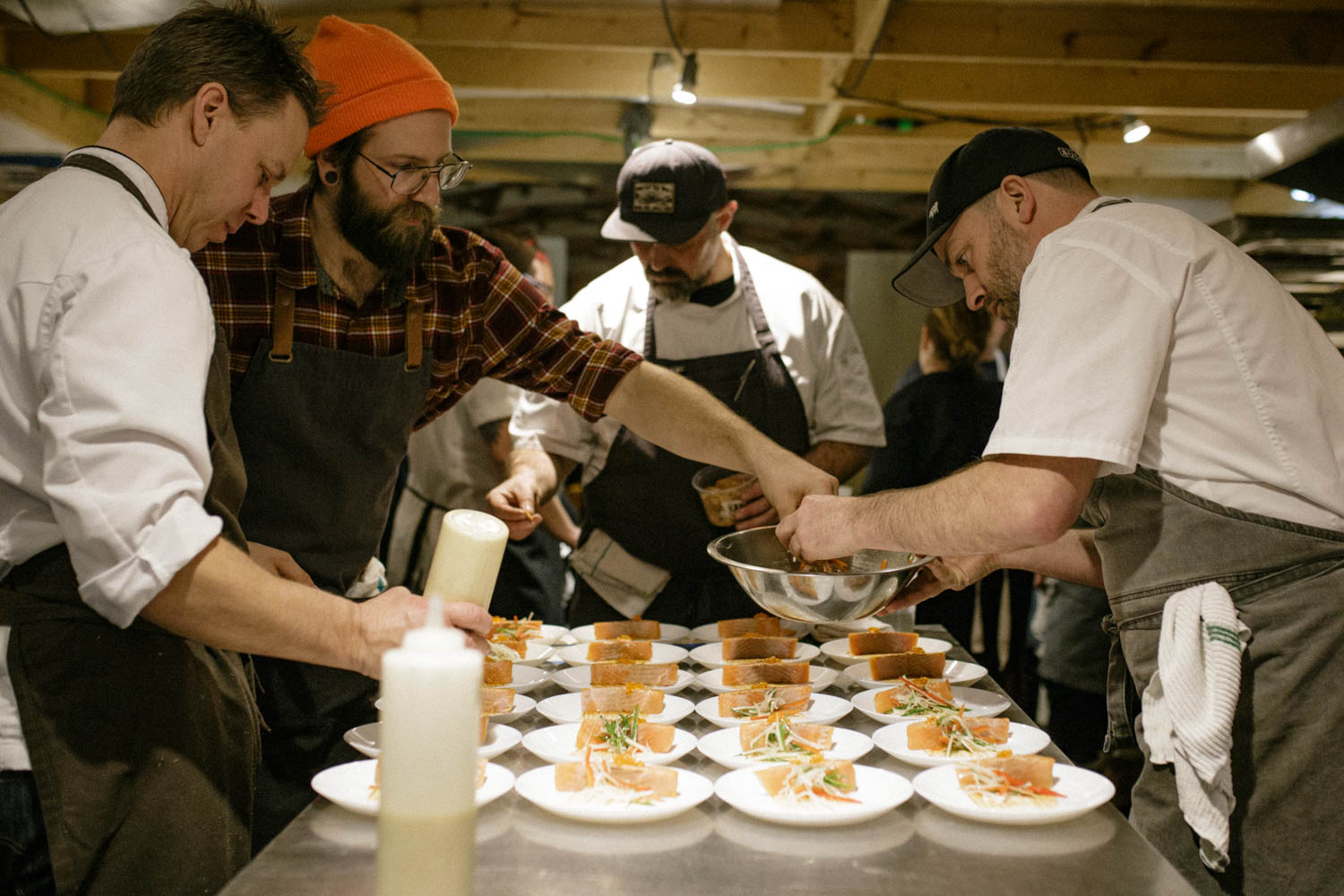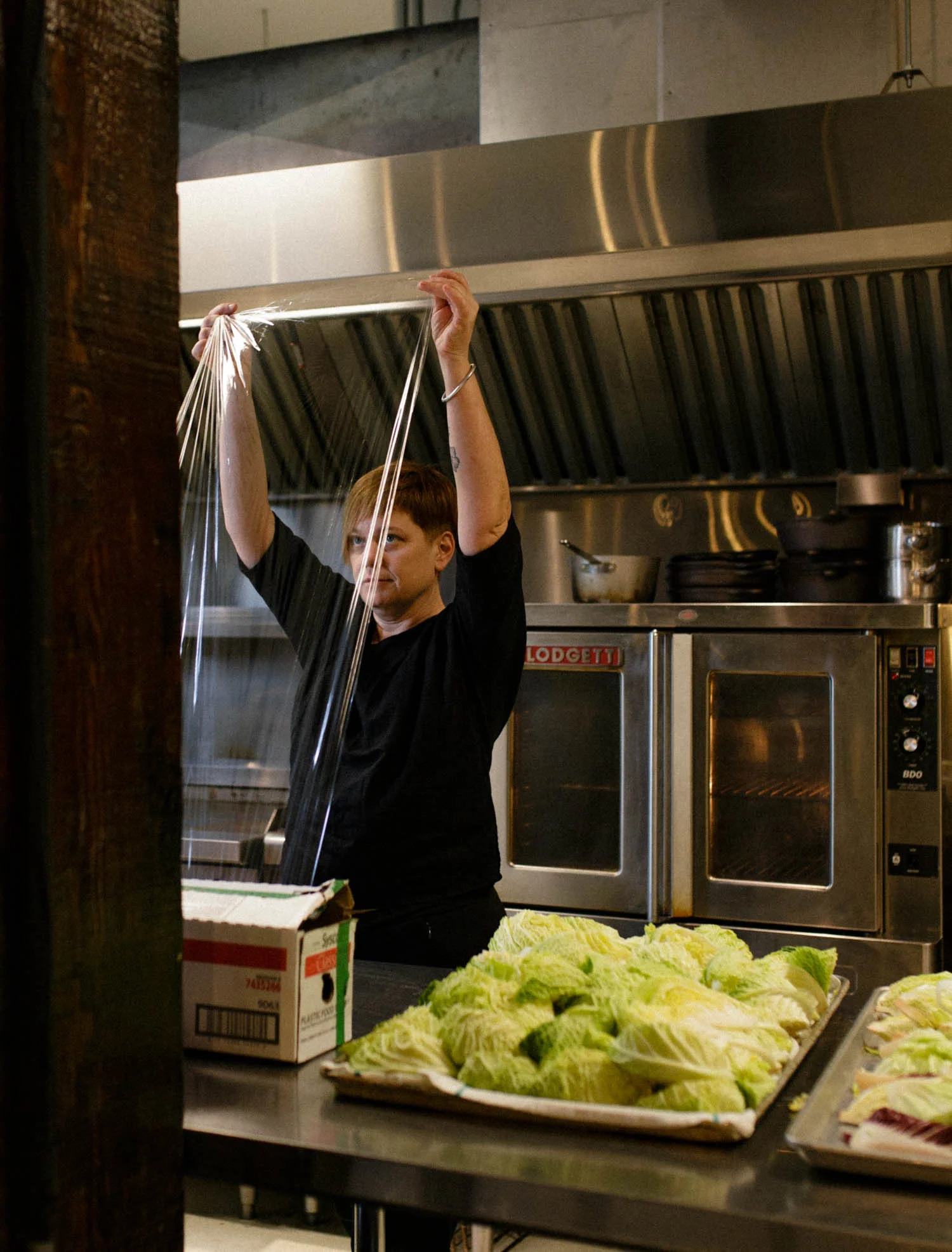Chef Ben Kramer on RAW:almond
Chef Ben Kramer’s never been one to shy away from an unfamiliar situation. After championing local and sustainable ingredients at the Dandelion Eatery, he moved on to redesigning the food services program at the University of Winnipeg in 2009. He took sad, overpriced and over-packaged cafeteria food, and started making everything from scratch, using low-cost, locally-sourced ingredients wherever possible.
Since leaving the university, Chef Kramer’s continued to break new ground. He now runs his own catering business, with help from fellow chef, Hank Mitchell, hosting dinners in private homes and even a barn or two. He was instrumental in getting Table for 1200, Canada’s longest and largest dinner table, off the ground and running. And he’s been part of Mandel Hitzer and Joe Kalturnyk’s project RAW:almond since it first started up in 2013.
In the last week of January, I had the chance to photograph Chef Kramer alongside other RAW chefs prepping at Kitchen Sync, then plating and serving down on the river later that night. The following week, we met for coffee at The Tallest Poppy to talk more about his work with RAW:almond.
FULL: You’ve been with RAW:almond since the beginning. What was the first year like?
Ben Kramer: We didn’t know if we were going to pull it off. It was a small group of chefs — they were all Winnipegers. We had no equipment, no money, and we just did it anyway.
FULL: How did you do it?
BK: Mandel and Joe, really. It’s their project. When Mandel gets an idea, we just figure it out, there is no “no.” We showed up and cooked on portable butane burners. The propane kept freezing, and we didn’t understand how to heat the structure properly, but we got through it and learned from it. Every year, we went, “What didn’t work and how can we make it better?” Now there’s a full commercial kitchen in there.
Our first year, there were quite a few issues. We struggled with the city, permits, insurance, the health department. It’s gotten better, but it used to be, “Hey, we want to do something that doesn’t fit into this box.” And the answer came back, “No.” We kept pushing. Table for 1200 was the same way. When we first approached the city for permits, without even hearing our plan, they went, “No. It’s too many people outside. You can’t do that.” It’s just been a process of figuring out how to make it happen.
FULL: What did you do to convince them?
BK: Lots of talking. With 1200, the health department had concerns with how we were going to do it safely. That’s a lot of food to put out at one time outside of a commercial kitchen. Food temperature is important for safety.
We did a lot of work for them. I had the equipment at the university to do a test run. We probed food and watched it on a bar graph to see how long it held heat. Now we’ve developed relationships with the city. The first year it’s “No,” the second year it’s, “How can we help?” When you’re trying to do something that hasn’t been done or isn’t done often, you have to handhold through it, and then prove yourself. I’m not trying to challenge the rules.
FULL: You have a lot of experience working in different kinds of kitchens. Do you find RAW:almond especially challenging?
BK: It’s a lot of work for Mandel and Joe to organize, but from the chef’s perspective, it’s relatively easy. It’s probably difficult for chefs who don’t cook outside of their kitchen, because they’re used to everything being in a certain spot, and they know exactly what their equipment’s like.
I cater for a living. I’m in a different kitchen for every event, so I don’t think about it as a challenge. At the end of the day, I’m cooking for twenty people, three times a night, with the same menu, and it’s a set menu. That aspect’s really easy. It allows us to be creative and try things. The people we’re feeding are into food and adventurous, so that gives us the opportunity to play more, and work with different ingredients and techniques.
FULL: What are some things you played with this year?
BK: We cooked cabbages in fire, but then froze them so the cell walls would break down. They were still raw, which gives you that pungent cabbage flavour, but because it’s frozen and then thawed, it had the texture of being cooked. In the past, we’ve played around with unique ingredients like insects. We always try to introduce it as a little piece, so that if you’re not into it, it doesn’t ruin your meal, it’s just one component. This year it was more technique driven for me — simple ingredients done really well.
Hank works with me year round, and our focus this last year has been honing what we’re already doing and improving it. We’ll always have that childlike attitude of playing with food, but this year, we made an intentional, conscious effort to work out the details of everything we’re doing. It was more about technique and systems and being organized.
FULL: Can you give me an example?
BK: Being a caterer in a different environment every single day, the instinct is to pack as much as possible just in case. Most chefs have the luxury of walking into a set up kitchen where all their stuff is. They turn on the lights and the hoods and gas and start cooking. We’re building that every single day somewhere else, so we have to pack as efficiently as possible. 90% of catering is moving things around. So we’ve figured out the bare essentials of what we need to execute a meal at the top of our game. We’ve gotten really good at that.
FULL: Something I definitely noticed being in the space at RAW was how many people there were in a small area. For me, I get agitated being in close quarters for long periods of time. Is that something you experience? Do you have a way of recovering from that?
BK: I spend a lot of time alone, which helps a lot. The night you were down there, there were a decent number of people because we were all collaborating. That increased the number of people, but it also made it really easy and fun. There are a lot of people, but it’s a number where everyone can do their job well. Hank and I work together all the time, so we can work around each other without even talking. It’s fun to learn that with new people.
FULL: I imagine as a chef, you have to develop is a pretty good body awareness.
BK: Everyone’s really aware of space, and not walking behind people without letting them know. All of those things are routine. I get more frustrated walking through a busy street or a mall than I do in that kitchen, because most people aren’t aware of their bodies. When I was working at the university, just walking through those halls full of students, I could pick out the kids who worked in the industry by how they moved through the hallways. It was very obvious that they were aware. It’s all about efficiency of movement.
FULL: Shooting the prep at Kitchen Sync, it also seemed like people were also getting along really well, talking things over and working together.
BK: I think we work together so well because there’s an overall lack of ego. We’re not there to one-up each other. There will always be friendly competition, but it’s competing with yourself more than anything. There have been people over the years who don’t come in with that spirit, and that’s fine, they just don’t come back, or they get another chance down the line. We had a few of those in the first couple years, where it’s like, “You’re not ready for community yet. We’ll talk when you’ve been out in the real world for awhile.”
The most magical part about RAW:almond is the stuff the guests don’t get to see — that community and camaraderie that brings us together in a way I don’t think any other project really has. We’re all in it together. Parts of it suck, but we’re also having fun. This year, we opened up Kitchen Sync to everybody for prep. Last year, it was mainly the out-of-town chefs who didn’t have a kitchen in Winnipeg. Everyone else prepped at their restaurants. This year, we had a lot of Winnipeg chefs, with their own kitchens who didn’t need to be there, come down. We all got to hang out and talk and see what we were doing. I’ve learned more this year just by hanging out in the kitchen and learning from people who do things I don’t do. The majority of the participating chefs are there for that sharing and collaboration.











